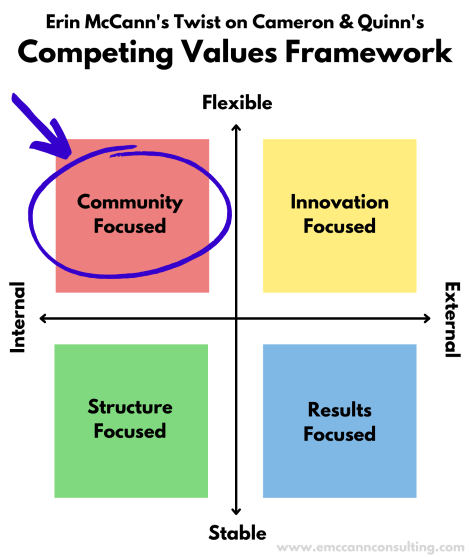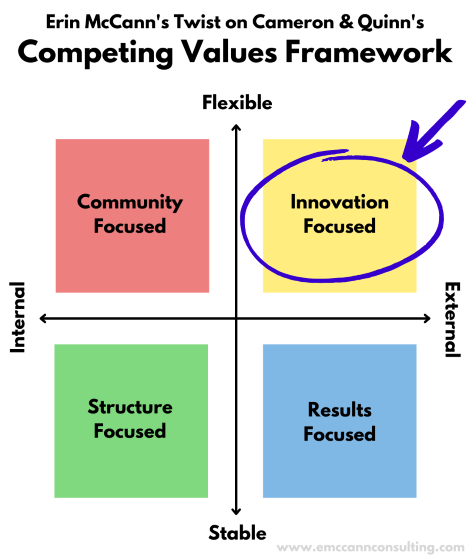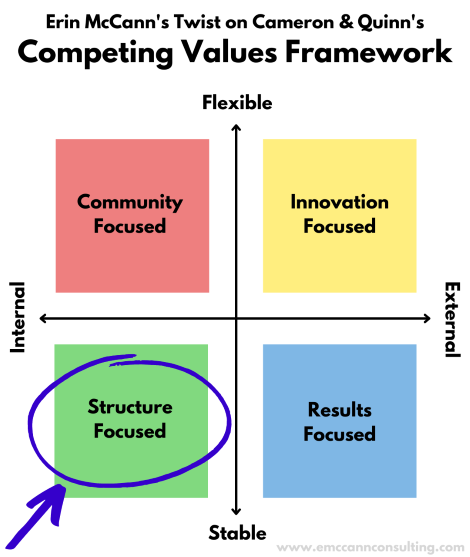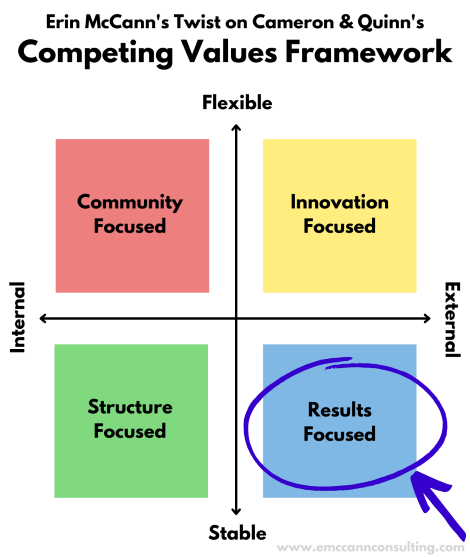4 Types of Organizational Culture, Part 2
Part 1 of this blog post went over Cameron & Quinn’s Competing Values Framework, explained the four types of organizational culture (with updated names to better suit our 21st century vernacular and perspective), and elaborated on the identities of each culture style as well as what kind of individual is most well suited for each.
Now that you know the four basic organizational culture styles (and have done a little soul searching about where your organization sits), let’s take a closer look at some of the pitfalls each style must navigate, and consider some suggestions about how to start the process of nurturing your culture with intentionality.
Two things to keep in mind as we embark on this little journey:
First, there is no right and wrong culture style. Often (in the process of drawing attention to aspects of work that are in dire need of a cultural overhaul), editorial writing tends to reduce one style or another to a short list of characteristics and motivations as if they were stock characters in a melodrama. Truthfully, no one of these styles is inherently good or bad, but each one comes with examples of organizations who have cultivated effective cultures and organizations who have cultivated harmful ones. This is why using a tool like this framework to see broadly where your organization falls is just the first step to understanding and nurturing your culture, and it’s why identifying the pitfalls is so important.
Secondly, under the heading of each culture style you’ll find important items to keep in mind, but these concepts are also applicable to the other styles. Equitable compensation, respecting boundaries, clearly communicating expectations, celebrating failures, etc. are all concepts that apply to every organization, regardless of style. Because no organization purely falls into one of the four categories, and because all organizations struggle with these pitfalls to some extent, I recommend reading through each category and trying to see your organization through that lens.
Let’s delve in!
The Community-Focused Quadrant
If you choose to read more about this quadrant elsewhere, you will see that a lot of writers throw around the phrase “like a family” to describe the vibe of this culture. Using the word family to describe a team can be harmful as it creates an artificial sense of loyalty that is rooted more in obligation than it is in mutual respect and common goals. While many people are leaning into this culture style and embracing more of a meet-your-people-where -they-are philosophy, there are many who have become skeptics after experiences with organizations that haven’t nurtured a healthy culture and/or done a poor job of communicating about it.
Equity is foundational.
The core tenets of this culture style are mutual respect and trust. This is dependent on all members of the organization (including leadership) striving to hear, see, and lift up all other members. Passion for mission, team spirit, and strong relationships are all secondary to adequate pay, respected boundaries, and demonstrated appreciation. Team members thrive and contribute when they reach the top (the self-actualization layer) of Maslow’s Hierarchy of Needs, but before this is possible, their basic needs (physiological and safety) and their psychological needs (belonging and esteem) must be supported.
Boundaries are essential.
Boundaries are an important part of every relationship. One major pitfall that organizations encounter as they attempt to foster a community-focused culture is deemphasizing (or disregarding) the boundaries of individuals. This is where the “family” metaphor becomes harmful. Yes, this is a culture that allows for vulnerability and sharing, but it is equally important to acknowledge and respect that each member of the team has their own comfort level.
Additionally, it is important to acknowledge and respect that each individual has limited time and capacity. A community-focused culture should be one in which everyone (to the extent that their own capacity allows) supports the individual that most needs support. This should be a culture of “acting as a team,” not a culture in which one is expected to “take one for the team.”
Be clear about your culture.
People outside of your organization have a limited understanding of how it functions, and stigmas exist for every type of culture. It is crucial that you communicate clearly and honestly about your current culture and the culture you are trying to foster. Be thoughtful about the words you select. It’s not as simple as subbing the words “clan” and “family” for “community;” you need to be specific about what community-focused culture does and doesn’t mean in the context of your organization. If it means a willingness to help coworkers who are struggling to pick up the slack, say that. If it does not mean that you’ll ask people to work unpaid overtime or come in on sick days to be a team player, say that. Demystify everything that new hires should expect and current team members should strive for. (For an excellent example of walking the walk, check out this gem of a culture guide the overachievers at Netflix put together.)
The Innovation-Focused Quadrant
This culture type is external facing, which means the focus is on the quality of the product, the satisfaction of the customer/user, and changing external needs. As a result, the organization can easily lose sight of the human element of operating as a team. It is important to maintain a sympathetic understanding of the wellbeing and job satisfaction of the individuals doing the work and to ensure that both current and future team members understand the priorities of the organization and the culture of the team.
Celebrate achievement and give credit.
When your organization equates success with innovation and your common goal is iterative progress, it is more likely than not that your team is made up of individuals who share these values. In addition to celebrating group wins, remember to appreciate the individual contributions upon which those groups successes are built. Regularly give credit to individuals whose creativity has moved the work forward, and celebrate the small victories. Celebrate ideas in order to motivate innovators.
Celebrate failures.
This culture style is all about throwing ideas against the wall to see what sticks. Forward progress depends on everyone having a sense of safety that allows them to bring their ideas forward. This sense of safety is challenged when ideas that aren’t ultimately viable are met with harsh criticism, treated as failures, or result in finger pointing. To avoid this problem, try to focus on showing appreciation for the creativity and work that went into the idea, the boldness it took to bring the idea forward, and the opportunity it presents to identify ways in which the team can learn, grow, and pivot.
Be explicit about boundaries and expectations.
This culture type relies on buy-in from every member of the team and the full team’s ability to pivot and solve problems creatively. For that reason, it is in the organization’s best interest to find and retain talented, agile, persistent individuals who fully understand what they have signed up for. For the job in general and for every project and subtask, expectations should be well communicated: what outcomes are expected, what time constraints exist, what success looks like, and what rigidity, flexibility, distinction, and overlap exists in the roles and responsibilities of the individuals involved.
The Structure-Focused Quadrant
Organizations with this culture style have to be mindful of both how they nurture their culture and how they manage the perception of their culture. This style is known for stability, which can mean consistency (a positive) or rigidity (a negative). It also puts a lot of emphasis on turning to the multi-tiered org-chart for delineation of responsibilities, chain of command, and status. This often divides organizations into those that present ample opportunities for advancement and those that are a “dead end” (or present concerns about job security). It is essential for this culture style to remember that the org chart is a functional system, not a static structure, and to make sure that that conceptualization is clear to everyone involved.
Be explicit about opportunities for advancement.
Job candidates often ask directly about opportunities for advancement in the hiring process, but rest assured, they are curious about it even if they don’t ask. The current team may also have questions about this:
Do you promote from within?
Are raises and promotions based on seniority, performance, innovation?
Is the current org-chart fixed, or will new positions be created?
People want to know where they stand and whether or not there is room for growth. Being upfront about potential future opportunities (or a lack thereof) will help dissuade team members from looking for those answers at other organizations.
Be explicit about expectations.
The flipside of the above coin is that many other people who thrive within this culture style do so because they appreciate comfort and dependability. These are individuals who may have carefully selected a job that fits within the unique structure of their lives. Everyone appreciates explicit expectations, but this group may perceive job insecurity where others saw room for ambition. To feel secure and continue to perform their job with confidence and consistency, this group needs to know whether they are expected to do their given responsibilities well or an expectation that they strive to climb. There is no right or wrong answer to that question, but transparency will result in trust, which in turn will lead to smoother operations.
Nurture support, not division.
Individuals are happier, healthier, and more productive on the job when they feel supported. In fact, health risk assessment questionnaires (HRAs) often ask about workplace friendships and levels of support as indicators of stress levels that may affect mental and heart health. Consider focusing efforts on the cultural divide between the levels of the org-chart:
What does communication look like between levels (aside from just the manager/direct-report relationships)?
Is there trust?
Is there access?
Do the various levels at the organization feel like they are a part of one team or siloed factions?
Another way that organizations can encourage a culture of support is to make sure that all team members have peers at their same level. Regardless of other efforts, a power difference is inherently baked into the relationships of employees at different levels, and power differences limit the vulnerability and support individuals can offer one another. Group morale suffers when an individual feels alienated, so it is essential for every team member to have access to other team members on the same rung of the ladder.
Results-Focused Quadrant
Results-focused organizations have their eye on the prize. They are focused on the market/sector and their place within it. The success factors are external, as are the factors that determine every move along the way. Similar to the innovation-focused organizations, results-focused organizations may find it challenging to remain mindful of the needs of the individuals on the team. While success is celebrated as a team, it is important to remember that the team consists of unique individuals, each of which makes an essential contribution to the whole.
Don’t lose sight of your people.
Retaining talent depends (in part) on job satisfaction. Leadership should make a conscious effort to understand the current state of team morale and the factors that affect it. It may benefit the organization to make a brief “temperature check” a normal part of one-on-one meetings with direct reports. Consider finding opportunities to talk to team members about their challenges and potential solutions.
Learning from the goals not reached.
Competition is inherently part of this culture style, and the team works towards common goals that allow them to compete and (hopefully) overtake the competition. How the organization handles falling short of a goal is just as important as how it celebrates a victory. Because of the focus on results, “the process” can feel like a long buildup between milestones. A shortfall inflates the gap between “good times” which can take its toll on a team. In extreme cases, falling short of a goal may even be perceived as a threat to job security.
While a shortfall may not be cause for celebration, it does present an opportunity to bring the team closer together. By framing these times as learning opportunities, an organization can show appreciation for the hard work of the team and create space for conversation around reflection and ideas for improvements. Think of the difference it could make to turn the dark spots into opportunities to let the team shine!
Determine how team successes translate into individual benefits.
Team members at a results-focused organization most likely derive some satisfaction from the glory of overtaking the competition or the prestige of belonging to a revered organization. These emotional highs, however, are not long term benefits. They ultimately don’t contribute to the sustainability of the team. It’s crucial that team successes translate into individual successes that benefit team members in a tangible way:
Does market placement affect raises or bonuses?
Is the team informed about how that works?
Do valued contributions to the organization’s market placement affect individuals’ eligibility for promotion?
Has that been communicated to the team?
Proper credit and appreciation are valuable, but proper compensation for merit in a results-focused organization is fundamental.
Turn Understanding into Action
Now that you have significantly more to chew on, look back at the framework. Think about where you placed the markers in the activity from Part 1 and ask yourself a few questions:
Do you still feel that they are all in the correct places?
Do you feel like you have a better understanding of why they are where they are?
Do you have ideas about how to bring them more into alignment with one another?
Creating intentional culture is not a quick process, and there is always more work to be done. Building a team culture that works well for the individuals that make up your team will ultimately make the organization more effective and sustainable. Creating incremental change is well worth the effort.
Not sure where to start? Have an idea but need a thought partner? Need an ally with the capacity to take on some of the legwork? I can help! Let’s connect and talk about what’s next!









